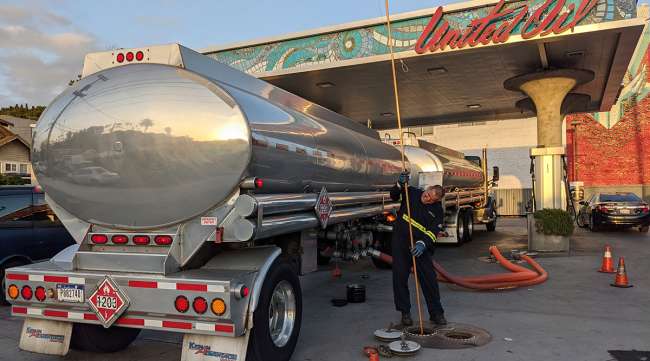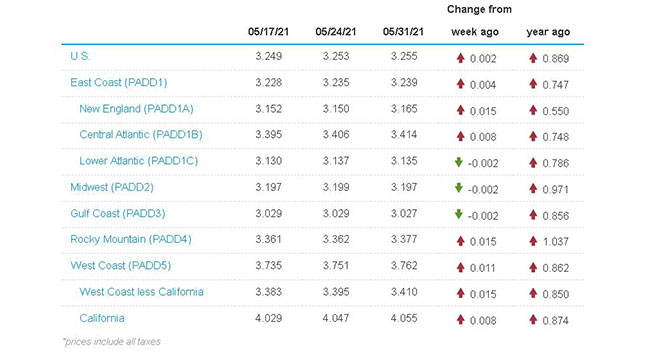Senior Reporter
Diesel Price Nearly Flat; Increase Is Only Two-Tenths of a Cent

[Stay on top of transportation news: Get TTNews in your inbox.]
The national average price of diesel barely moved this past week, inching up two-tenths of a cent, according to Energy Information Administration data released May 31.
The past two weeks combined have seen an increase of just more than a half a penny, after trucking’s main fuel rose four-tenths of a cent May 24.
A gallon of diesel now costs 86.9 cents more than it did at this time in 2020.
U.S. average on-highway #diesel fuel price on May 31, 2021 was $3.255/gal, UP 0.2¢/gallon from 5/24/21, UP 86.90¢/gallon from year ago https://t.co/3fCONQfuRs #truckers #shippers #fuelprices pic.twitter.com/Ql9gKnPby1 — EIA (@EIAgov) June 2, 2021
The average cost for a gallon of diesel rose in seven of the 10 regions in EIA’s weekly survey, with the largest being 1.5 cents on the West Coast less California, the Rocky Mountain region and New England. In the Lower Atlantic, Midwest and Gulf Coast, the decrease matched the national average of two-tenths of a cent.
Gasoline increased seven-tenths of a cent to $3.027 a gallon after a decline of eight-tenths of a cent May 24.
West Texas Intermediate crude rose 2.1% while global benchmark Brent settled above $70 a barrel for the first time since 2019, according to Bloomberg News. Prices rallied as members of the OPEC+ alliance sounded upbeat notes about the global consumption rebound.
In its latest Summer Fuels Outlook report, the EIA said the rising price of oil is directly moving all petroleum products including gasoline, diesel and jet fuel higher and that is likely to continue throughout the summer as more people travel and the U.S. economy continues its post-COVID pandemic recovery.
“Because gasoline taxes and retail distribution costs are generally stable, movements in gasoline and diesel prices are primarily the result of changes in crude oil prices and wholesale margins, both of which are heading into summer 2021 at nearly their highest levels since before the COVID-19 pandemic began,” the report said.
“EIA forecasts the Brent crude oil price will average $64 a barrel this summer, compared with an average of $36 a barrel last summer,” the report continued. “Any difference between actual crude oil prices and our forecast would likely be reflected in the retail price of fuel at the pump. Absent other factors specific to the gasoline and diesel fuel markets, each dollar per barrel of sustained price change in crude oil compared with the forecast translates into a 2.4-cent-per-gallon change in product prices.”
The EIA said it expects diesel prices on average nationwide this summer to be more than 50 cents a gallon higher than last year. The forecast is for a gallon to cost $2.96, compared with $2.43 a gallon last summer and up from the recent five-year summer average of $2.73 a gallon.
U.S. average price for regular-grade #gasoline on May 31, 2021 was $3.027/gal, UP 0.7¢/gallon from 5/24/21, UP $1.053/gallon from year ago https://t.co/JalsnF1hiL #gasprices pic.twitter.com/WEmNXBhiJr — EIA (@EIAgov) June 2, 2021
Petroleum industry analyst Phil Flynn told Transport Topics that the oil industry has, for the most part, recovered from the shock of the shutdown of the Colonial Pipeline after suspected Russian hackers received millions of dollars in ransom from the pipeline’s operators. But now he says the summer driving season has begun and demand is increasing.
“I think we’re going to see steady price increases, maybe some dips along the way,” Flynn said. “The reopening of the economy is getting stronger and stronger and we’re building momentum as we build to the Fourth of July holiday. People are demanding more products and goods, businesses are demanding more products and goods and that’s going to keep truckers on the road and you have more people flying, so jet fuel demand is up.”
As the U.S. economy recovers and the price of oil increases, domestic oil production is beginning to speed up. The latest Baker-Hughes Rig Count shows 457 rigs were in operation the last week of May, up by two from the previous week. But when measured against 2020’s deep decline in oil production the number is up 156 from late May 2020.
The latest EIA report on domestic production, dated May 28, showed that in March, U.S. producers pulled nearly 11.2 million barrels of oil a day out of the ground, up 14.5% from the COVID-19 pandemic low of 9.78 million barrels just a month before. Domestic oil production peaked in December 2019 when 12.8 million barrels per day were pumped, but then the number plunged as the pandemic took hold in March 2020.
Flynn says in addition to the improving economy helping to spur production, oil producers are encouraged by the higher prices, especially after losing tens of millions of dollars during the pandemic.
“I think you’ll see the rig count continuing to go up, but the oil producers are cautious,” Flynn said. “In the past when we saw this type of price increase, oil production would be leaping higher, but now it’s creeping higher.”
U.S. On-Highway Diesel Fuel Prices

EIA.gov
Want more news? Listen to today's daily briefing below or go here for more info:




